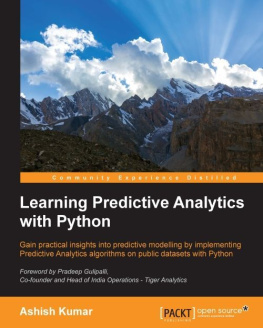Thomas W. Miller [Thomas W. Miller] - Modeling Techniques in Predictive Analytics with Python and R: A Guide to Data Science
Here you can read online Thomas W. Miller [Thomas W. Miller] - Modeling Techniques in Predictive Analytics with Python and R: A Guide to Data Science full text of the book (entire story) in english for free. Download pdf and epub, get meaning, cover and reviews about this ebook. year: 2014, publisher: PH Professional Business, genre: Home and family. Description of the work, (preface) as well as reviews are available. Best literature library LitArk.com created for fans of good reading and offers a wide selection of genres:
Romance novel
Science fiction
Adventure
Detective
Science
History
Home and family
Prose
Art
Politics
Computer
Non-fiction
Religion
Business
Children
Humor
Choose a favorite category and find really read worthwhile books. Enjoy immersion in the world of imagination, feel the emotions of the characters or learn something new for yourself, make an fascinating discovery.
- Book:Modeling Techniques in Predictive Analytics with Python and R: A Guide to Data Science
- Author:
- Publisher:PH Professional Business
- Genre:
- Year:2014
- Rating:5 / 5
- Favourites:Add to favourites
- Your mark:
Modeling Techniques in Predictive Analytics with Python and R: A Guide to Data Science: summary, description and annotation
We offer to read an annotation, description, summary or preface (depends on what the author of the book "Modeling Techniques in Predictive Analytics with Python and R: A Guide to Data Science" wrote himself). If you haven't found the necessary information about the book — write in the comments, we will try to find it.
Master predictive analytics, from startto finish
Start with strategy and management
Master methods and build models
Transform your models into highly-effectivecodein both Python and R
This one-of-a-kind book will help you usepredictive analytics, Python, and R to solve real business problemsand drive real competitive advantage. Youll masterpredictive analytics through realistic case studies, intuitive datavisualizations, and up-to-date code for both Python and Rnotcomplex math.
Step by step, youll walk throughdefining problems, identifying data, crafting and optimizingmodels, writing effective Python and R code, interpreting results,and more. Each chapter focuses on one of todays keyapplications for predictive analytics, delivering skills andknowledge to put models to workand maximize their value.
Thomas W. Miller, leader of NorthwesternUniversitys pioneering program in predictive analytics,addresses everything you need to succeed: strategy and management,methods and models, and technology and code.
If youre new to predictive analytics,youll gain a strong foundation for achieving accurate,actionable results. If youre already working in the field,youll master powerful new skills. If youre familiarwith either Python or R, youll discover how these languagescomplement each other, enabling you to do even more.
All data sets, extensive Python and R code,and additional examples available for download athttp://www.ftpress.com/miller/
Python and R offer immense power inpredictive analytics, data science, and big data. This book willhelp you leverage that power to solve real business problems, anddrive real competitive advantage.
Thomas W. Millers unique balancedapproach combines business context and quantitative tools,illuminating each technique with carefully explained code for thelatest versions of Python and R. If youre new to predictiveanalytics, Miller gives you a strong foundation for achievingaccurate, actionable results. If youre already a modeler,programmer, or manager, youll learn crucial skills youdont already have.
Using Python and R, Miller addressesmultiple business challenges, including segmentation, brandpositioning, product choice modeling, pricing research, finance,sports, text analytics, sentiment analysis, and social networkanalysis. He illuminates the use of cross-sectional data, timeseries, spatial, and spatio-temporal data.
Youll learn why each problem matters,what data are relevant, and how to explore the data youveidentified. Miller guides you through conceptually modeling eachdata set with words and figures; and then modeling it again withrealistic code that delivers actionable insights.
Youll walk through modelconstruction, explanatory variable subset selection, andvalidation, mastering best practices for improving out-of-samplepredictive performance. Miller employs data visualization andstatistical graphics to help you explore data, present models, andevaluate performance. Appendices include five complete casestudies, and a detailed primer on modern data science methods.
Use Python and R to gain powerful,actionable, profitable insights about:
Advertising and promotion
Consumer preference and choice
Market baskets and related purchases
Economic forecasting
Operations management
Unstructured text and language
Customer sentiment
Brand and price
Sports team performance
And much more
Thomas W. Miller [Thomas W. Miller]: author's other books
Who wrote Modeling Techniques in Predictive Analytics with Python and R: A Guide to Data Science? Find out the surname, the name of the author of the book and a list of all author's works by series.

![Thomas W. Miller [Thomas W. Miller] Modeling Techniques in Predictive Analytics with Python and R: A Guide to Data Science](/uploads/posts/book/119642/thumbs/thomas-w-miller-thomas-w-miller-modeling.jpg)

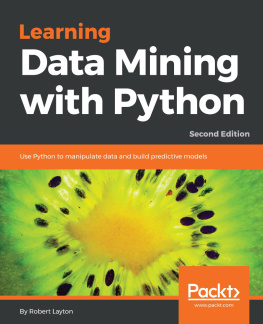
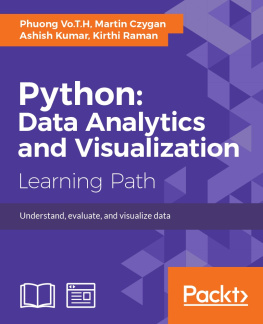
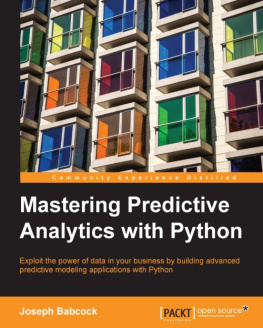
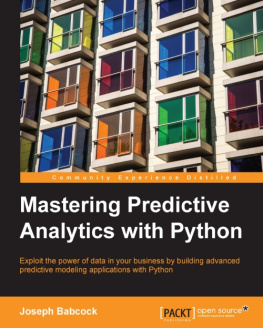
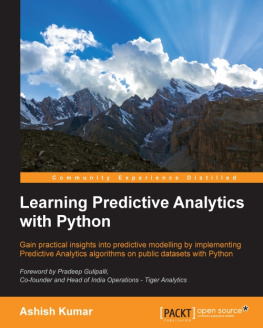
![Thomas W. Miller [Thomas W. Miller] - Web and Network Data Science: Modeling Techniques in Predictive Analytics](/uploads/posts/book/119619/thumbs/thomas-w-miller-thomas-w-miller-web-and.jpg)
![Thomas W. Miller [Thomas W. Miller] - Sports Analytics and Data Science: Winning the Game with Methods and Models](/uploads/posts/book/119598/thumbs/thomas-w-miller-thomas-w-miller-sports.jpg)
![Thomas W. Miller [Thomas W. Miller] - Marketing Data Science: Modeling Techniques in Predictive Analytics with R and Python](/uploads/posts/book/119596/thumbs/thomas-w-miller-thomas-w-miller-marketing.jpg)
